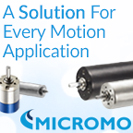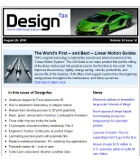 |
| February 26, 2019 | Volume 15 Issue 08 |
Motion Control News & Products
Designfax weekly eMagazine
Archives
Partners
Manufacturing Center
Product Spotlight
Modern Applications News
Metalworking Ideas For
Today's Job Shops
Tooling and Production
Strategies for large
metalworking plants
How to maximize and optimize stepper motor control
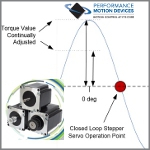 Engineers from Performance Motion Devices take a comprehensive look at how to control two-phase stepper motors, beginning with the basics (operations, strengths and weaknesses) and moving on to traditional and updated advanced techniques for control including closed loop. A very thorough presentation.
Engineers from Performance Motion Devices take a comprehensive look at how to control two-phase stepper motors, beginning with the basics (operations, strengths and weaknesses) and moving on to traditional and updated advanced techniques for control including closed loop. A very thorough presentation.
Read this informative Performance Motion Devices article.
Ergoswiss table lifting systems from AutomationDirect
 Automation-Direct has added the new SQ series table lifting systems from Ergoswiss. These lifting systems use electrically driven columns that allow the operator to reposition the height of a worktable, conveyor, etc. to meet specific requirements. In doing so, the operator can perform their tasks in a more comfortable working posture, helping to reduce work-related injuries. These systems are all electric (no hydraulic mess or manual hand cranks), and each lifting column features a housed motor and screw drive to perform the needed height adjustments.
Automation-Direct has added the new SQ series table lifting systems from Ergoswiss. These lifting systems use electrically driven columns that allow the operator to reposition the height of a worktable, conveyor, etc. to meet specific requirements. In doing so, the operator can perform their tasks in a more comfortable working posture, helping to reduce work-related injuries. These systems are all electric (no hydraulic mess or manual hand cranks), and each lifting column features a housed motor and screw drive to perform the needed height adjustments.
Learn more.
Compact linear voice coil servo motor with built-in shaft and bearing
![]() The GVCM-032-025-02M Linear Voice Coil Servo Motor is the first of a new series of non-commutated, brushless linear servo motors from Moticont. This clean and quiet unit has a 12.7-mm stroke with built-in shaft and bearing, a continuous high-force-to-size ratio of 9.3 N (2.1 lb), and 29.3 N (6.6 lb) of peak force at a 10% duty cycle. Features include: high reliability, high speed, zero cogging, high acceleration/deceleration, and, when used in a servo loop, very high accuracy and repeatability. An ideal choice for: haptic feedback, medical devices, laser machining and drilling, work holding and clamping, scanners, optical focusing, testing, sorting, and assembly.
The GVCM-032-025-02M Linear Voice Coil Servo Motor is the first of a new series of non-commutated, brushless linear servo motors from Moticont. This clean and quiet unit has a 12.7-mm stroke with built-in shaft and bearing, a continuous high-force-to-size ratio of 9.3 N (2.1 lb), and 29.3 N (6.6 lb) of peak force at a 10% duty cycle. Features include: high reliability, high speed, zero cogging, high acceleration/deceleration, and, when used in a servo loop, very high accuracy and repeatability. An ideal choice for: haptic feedback, medical devices, laser machining and drilling, work holding and clamping, scanners, optical focusing, testing, sorting, and assembly.
Learn more.
Optical rotary encoders: Close the stepper motor linear actuator feedback loop
 With the help of a motion controller and a stepper driver, all stepper motor linear actuators can be programmed to position a load to a precise location. However, standard configurations do not provide a feedback mechanism that tells the operator whether the move is completed or not. Adding an encoder can be an effective and simple solution to get real-time motion feedback about your application.
With the help of a motion controller and a stepper driver, all stepper motor linear actuators can be programmed to position a load to a precise location. However, standard configurations do not provide a feedback mechanism that tells the operator whether the move is completed or not. Adding an encoder can be an effective and simple solution to get real-time motion feedback about your application.
Read this informative Thomson article.
Overhead conveyor drives for automotive, food processing
 Overhead conveyor drives from NORD DRIVE-SYSTEMS are engineered with long-lasting performance and durability in mind. They feature high-quality components, heavy-duty construction, and an output mounting flange and shaft for easy drop-in replacement of industry-standard footprints. They are an ideal solution for meat and poultry processing, automotive assembly, and other manufacturing systems where utilization of vertical space is required. Lots of options and many more features.
Overhead conveyor drives from NORD DRIVE-SYSTEMS are engineered with long-lasting performance and durability in mind. They feature high-quality components, heavy-duty construction, and an output mounting flange and shaft for easy drop-in replacement of industry-standard footprints. They are an ideal solution for meat and poultry processing, automotive assembly, and other manufacturing systems where utilization of vertical space is required. Lots of options and many more features.
Learn more.
New micro motor controller elevates precision, speed, and torque management
 maxon, a leader in DC motor and drive solutions, has unveiled its latest innovation: the ESCON 2 controller. This advanced speed and current controller, designed for micro motors, significantly enhances control precision. The ESCON 2, suitable for brushed and brushless DC motors up to 1,800 W continuous duty, is engineered for seamless OEM integration into customer systems. Enhanced control features include field-oriented control (FOC), acceleration, and velocity feed-forward capabilities. Supports 4-quadrant operation. Lots more features. Available from Electromate.
maxon, a leader in DC motor and drive solutions, has unveiled its latest innovation: the ESCON 2 controller. This advanced speed and current controller, designed for micro motors, significantly enhances control precision. The ESCON 2, suitable for brushed and brushless DC motors up to 1,800 W continuous duty, is engineered for seamless OEM integration into customer systems. Enhanced control features include field-oriented control (FOC), acceleration, and velocity feed-forward capabilities. Supports 4-quadrant operation. Lots more features. Available from Electromate.
Learn more and get all the specs.
Next-gen motor for pump and fan applications
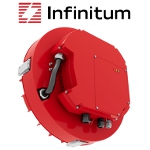 The next evolution of the award-winning Aircore EC motor from Infinitum is a high-efficiency system designed to power commercial and industrial applications such as HVAC fans, pumps, and data centers with less energy consumption, reduced emissions, and reduced waste. It features an integrated variable frequency drive and delivers upward of 93% system efficiency, as well as class-leading power and torque density in a low-footprint package that is 20% lighter than the previous version. Four sizes available.
The next evolution of the award-winning Aircore EC motor from Infinitum is a high-efficiency system designed to power commercial and industrial applications such as HVAC fans, pumps, and data centers with less energy consumption, reduced emissions, and reduced waste. It features an integrated variable frequency drive and delivers upward of 93% system efficiency, as well as class-leading power and torque density in a low-footprint package that is 20% lighter than the previous version. Four sizes available.
Learn more.
Deep learning-based part detection for machine tending cobots: Universal Robots at IMTS
 Universal Robots, the pioneer of collaborative robotics, is set to unveil a new AI-powered machine tending solution at IMTS, enabling faster batch changeovers by eliminating the need for fixtures. Additionally, the company will showcase advanced cobot applications for welding, finishing, part feeding, and laser marking. Lots of useful tech here.
Universal Robots, the pioneer of collaborative robotics, is set to unveil a new AI-powered machine tending solution at IMTS, enabling faster batch changeovers by eliminating the need for fixtures. Additionally, the company will showcase advanced cobot applications for welding, finishing, part feeding, and laser marking. Lots of useful tech here.
Read the full article.
Why air bearings are used to test satellites
 The number of active satellites in space keeps growing, with more than 10,000 active satellites orbiting our planet. Commercial and academic institutions developing these satellites continuously work on improved test systems and methodologies to fully validate their hardware before launch. Learn why PI's 3-DOF spherical air bearing systems are an important part of this process.
The number of active satellites in space keeps growing, with more than 10,000 active satellites orbiting our planet. Commercial and academic institutions developing these satellites continuously work on improved test systems and methodologies to fully validate their hardware before launch. Learn why PI's 3-DOF spherical air bearing systems are an important part of this process.
Read the full article.
8 key advantages of torque motors for advanced applications
 Electric torque motors drive loads at low speed without additional mechanical transmission systems like gearboxes or speed reducers. They are known for smooth operation with less vibration and backlash. Learn the key benefits that make them a solid choice for many applications.
Electric torque motors drive loads at low speed without additional mechanical transmission systems like gearboxes or speed reducers. They are known for smooth operation with less vibration and backlash. Learn the key benefits that make them a solid choice for many applications.
View this informative Parker blog.
Gear motors with QR codes for product info
 NORD DRIVE-SYSTEMS gear motors now come with a QR code sticker on the unit enabling users to access information almost instantly such as product specs, documentation, and service requests via mobile device. The codes can be scanned using a photo app or QR code app and will bring the user to NORD's digital service webpage, which includes a Documentation Center, Spare Parts Shop, customer portal, and more. QR code stickers are now in use at NORD USA's four facilities in Waunakee, WI; Corona, CA; Charlotte, NC; and McKinney, TX.
NORD DRIVE-SYSTEMS gear motors now come with a QR code sticker on the unit enabling users to access information almost instantly such as product specs, documentation, and service requests via mobile device. The codes can be scanned using a photo app or QR code app and will bring the user to NORD's digital service webpage, which includes a Documentation Center, Spare Parts Shop, customer portal, and more. QR code stickers are now in use at NORD USA's four facilities in Waunakee, WI; Corona, CA; Charlotte, NC; and McKinney, TX.
Learn more.
LM guide actuator with right/left ball screw for symmetrical movement
 THK's innovative Type KR-RL Actuator features a driving element that uses right/left threads and enables symmetrical movements with a single motor. Two drive systems are combined into a single package, resulting in a compact overall design. This electric actuator outperforms pneumatic versions by offering precise force control, speed control, a longer life, and energy savings. Applications include gripping, measuring, and positioning for robot hands, screw-tightening machines, cutting equipment, and dispensers.
THK's innovative Type KR-RL Actuator features a driving element that uses right/left threads and enables symmetrical movements with a single motor. Two drive systems are combined into a single package, resulting in a compact overall design. This electric actuator outperforms pneumatic versions by offering precise force control, speed control, a longer life, and energy savings. Applications include gripping, measuring, and positioning for robot hands, screw-tightening machines, cutting equipment, and dispensers.
Learn more.
High-power-density outer-rotor brushless motor
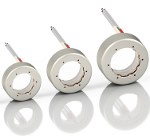 Allied Motion Technologies has released the new KinetiMax High Power Density (HPD) motor series. This outer-rotor brushless motor is designed for high-torque, low-cogging applications like robotics, AGVs, and handheld power tools. With an efficiency rating of over 85% and a high power-to-weight ratio, it's an ideal motor choice for any application where weight and battery life are critical. Available in six frame sizes, with three stack lengths per size and three windings per stack length.
Allied Motion Technologies has released the new KinetiMax High Power Density (HPD) motor series. This outer-rotor brushless motor is designed for high-torque, low-cogging applications like robotics, AGVs, and handheld power tools. With an efficiency rating of over 85% and a high power-to-weight ratio, it's an ideal motor choice for any application where weight and battery life are critical. Available in six frame sizes, with three stack lengths per size and three windings per stack length.
Learn more.
Universal Robots: Seamless integration with Siemens PLCs
 Cobot leader Universal Robots has integrated the Standard Robot Command Interface (SRCI) into its software. UR is proud to be among the first cobot vendors to offer this functionality, which is a new standard for robotics manufacturers that aims to create a single interface between PLCs and robots. It will ensure customers a frictionless integration with Siemens Programmable Logic Controllers, since Siemens is the first -- and currently only -- PLC Vendor supporting SRCI in the automation market.
Cobot leader Universal Robots has integrated the Standard Robot Command Interface (SRCI) into its software. UR is proud to be among the first cobot vendors to offer this functionality, which is a new standard for robotics manufacturers that aims to create a single interface between PLCs and robots. It will ensure customers a frictionless integration with Siemens Programmable Logic Controllers, since Siemens is the first -- and currently only -- PLC Vendor supporting SRCI in the automation market.
Learn more.
Multi-axis motion control chipset
 The Magellan® MC58000 and MC55000 Motion Control ICs from Performance Motion Devices provide all the advanced motion control required by sophisticated high-precision medical, scientific, automation, industrial, and robotic applications. Available in 1-, 2-, 3-, and 4-axis versions, these programmable devices control brushless DC, DC brush, and step motors and deliver user-selectable profiling modes including S-curve, trapezoidal, velocity contouring, and electronic gearing. High-performance FOC provides high-accuracy, ultra-low noise motor operation.
The Magellan® MC58000 and MC55000 Motion Control ICs from Performance Motion Devices provide all the advanced motion control required by sophisticated high-precision medical, scientific, automation, industrial, and robotic applications. Available in 1-, 2-, 3-, and 4-axis versions, these programmable devices control brushless DC, DC brush, and step motors and deliver user-selectable profiling modes including S-curve, trapezoidal, velocity contouring, and electronic gearing. High-performance FOC provides high-accuracy, ultra-low noise motor operation.
Learn more.
Continental pioneers tire tests with self-driving test vehicles -- although they had an electronically controlled test car 50 years ago
At its test site in Uvalde, Texas, the vehicle technology company Continental has commissioned the first driverless tire test vehicle for a wide range of road surface types. The aim is to make the test results for Continental's passenger and light-truck tires more conclusive while minimizing the impact of the test procedure on the final results. The new test vehicle is based on Continental's automated Cruising Chauffeur, which was developed for freeways.
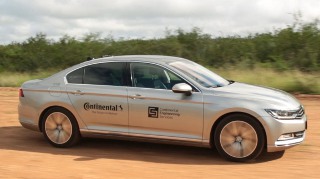
The automated vehicle does not only improve test results but it also subjects the test track to less wear and tear. [© Continental AG]
The test vehicle is controlled using a satellite-based navigation system. Equipped with camera and radar sensors, the car will be able to react immediately to people, animals, or other unexpected objects on the track, even without a driver. The development team from Uvalde is thereby contributing to making Continental's Vision Zero strategy for accident-free driving a reality.
"In critical situations, the tires' level of technology is the deciding factor in whether a vehicle brakes in time," explains Nikolai Setzer, member of the Continental Executive Board and head of the Tire division. "With tire tests which use an automated vehicle, we achieve highly conclusive test results and thereby ensure the premium quality of our tires."
Newly developed tire models must be tested under real conditions
One of the challenging tasks in tire production is to carry out quality tests while tires are in use. Newly developed rubber compounds and tire models have to be tested under real-life conditions, showing how well they perform on gravel roads, for example. Driving the test vehicles places huge demands on the drivers, as even the smallest deviations on the test track can have a huge impact on the quality and comparability of the test results.
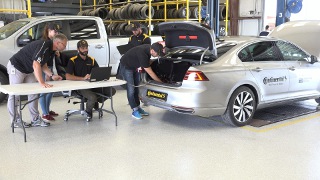
Thomas Sych and his team of engineers and students work on the prototype for an automated tire-testing vehicle. [© Continental AG]
Since 2016, the team led by Thomas Sych, head of Tire Testing at Continental, has been working on the tire test of the future in Uvalde. "We want to automate and thus standardize tire tests to such an extent that we can identify even the smallest differences in the tires," explains Sych. "The automated vehicle enables us to reproduce processes precisely, meaning that every tire in the test experiences exactly the same conditions. This way, we can be sure that differences in the test are actually caused by the tires and not by the test procedure."
This is not new territory for the company. Continental engineers developed an electronically controlled car to automate tire tests 50 years ago. Back then, the vehicle followed a wire that was glued to the track, which limited its use to asphalt test tracks. Today's prototype can also safely navigate along gravel roads without a driver.
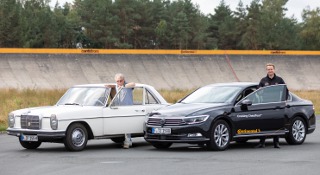
Meeting of the Generations: Former Continental engineer Herbert Ulsamer (left) with one of Continental's "old-school" wire-following test cars and Continental engineer Dennis Scholl with his new test vehicle, "Cruising Chauffeur." [© Continental AG]
In addition to the significantly improved comparability of the results, the tire test using automated vehicles will also reduce the maintenance work required for the test tracks. Because the vehicle is sent on a route that varies by just a few centimeters each time, the test track is subjected to less wear and tear, thus requiring considerably less maintenance.
"Thanks to close collaboration with colleagues from many different areas of Continental, we have made a lot of progress with our prototype for the tire test. Our focus now is on further developing the necessary camera and radar systems for this special case of off-road routes, so that the vehicle can react appropriately when people, animals, or other vehicles unexpectedly appear on the route," explains Sych. "We know from our own research, such as the Continental Mobility Studies, that trust is extremely important for the mobility of the future. We are fully aware of this responsibility when developing these new technologies."
Source: Continental
Published February 2019
Rate this article
View our terms of use and privacy policy
